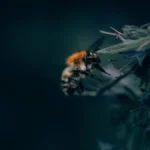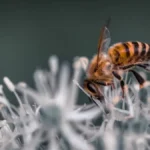Can bees fly at night? Yes. Can they fly well at night? That depends on a number of factors. We will have a look at this and visit a few humorous incidents that I have encountered over the years involving bees, night time and flying.
How Do Bees Fly?
It is quite simple – they clip their wings together and then buzz the wings and steer using the angle of their wings and even their little feet. If you get a chance, put some honey out, get the bees to come and start collecting it and then put a cell phone close to the comb and do a slo-mo video of a bee as she comes into land. There is a lot of fancy flying technique stuff going on that would put an ace helicopter pilot to shame.
The important thing here is that bees can fly, and they use their eyes, and to an extent their antennae to navigate towards visual and odor targets. In order to navigate using their eyes, they need bee visible spectrum light. But herein lies a catch.
Learn more about: Can Bees Bite Humans?
How Do Bees Fly-In Straight Lines?
Honeybees fly perpendicular to the Sun. The Sun is about 92,955,807 miles away, so flying perpendicular to this light source results in a nearly straight line of flight. Under full Moon conditions when there are very strong honey flows, the bees will occasionally fly at night using the Moon as a light source. The moon is about 238,855 miles away. If bees fly perpendicular to the Moon, the line of flight will be relatively straight.
How Did We Mess All Of This Up?
Until rather recently the only real sources of light that were bright enough for bees to see were the Sun, the Moon, fire, and lightning. Navigating by lightning is a poor evolutionary choice, so bar possibly Microsoft, nothing in its right mind would ever have thought of this.
Recently, humans have burst onto the scene and we have unleashed a tidal wave of light pollution upon our planet. To insects, this has been catastrophic. Electric lights are generally close to the ground. If a bee flies perpendicular to this electric light, it will spiral rapidly towards the light and eventually end up stuck on the bulb. Here it will buzz against the bulb until it either gets cooked by the bulb or runs out of energy.
Now that we have run over this brief intro to how and why bees fly at night, let us see how this affects us.
Do Bees Fly At Night?
Moonlight
As we have said, yes, they will naturally fly under a bright moon if there is a strong honey flow. I have seen this first hand so I know it’s true.
In The Dark
If it is dark, and a hive is disturbed, they will pour out and cover the surface of the hive with a buzzing hissing mass of bees. Every now and then one of these bees will fly off – I have watched these bees with a red light (bees cannot see red) and my general observation is they have not the foggiest idea where they are going.
They fly in a deranged spiral a bit like popcorn leaving a pot without a lid. If one of these angry bees hits you, it will sting you. Then other bees smell the anger pheromone and seem to fly straight at you and sting you.
So, we have now shown that bees can fly at night. If we were to ask “Do bees attach at night?” the answer is also yes. Now we combine that little bit of knowledge and add a curveball.
Do Lights Make Bees Attack At Night?
We know that bees will navigate towards a white light at night as they can see the light and mistake it for the Sun or Moon. They fly perpendicular to this light and spiral into it.
Headlamps
Now let us just imagine you are a beekeeper with a headlamp on your head and it is producing white light. If the bees get angry, you will have a cloud of bees stuck on your head in a few minutes. This is why we use red light headlamps at night.
You can run a simple test working your bees. Use a headlamp like this. Try working bees at night with the white light LED on, then shift to the red. You will probably only need to do this demonstration once.

Bathroom Lights
I was once called to a girls frat house and they told me they had a problem with bees. Two of the girls were standing with their legs at a very strange angle and they said to me that the bees had stung them “down there”. There was a generally high level of unhappiness in the air and everyone was quite scared as apparently if you are a girl that “down there” sting is a very very bad experience.
Over the years I have encountered this problem repeatedly and have discovered how this happens. Many people leave the bathroom light on at night. In the middle of summer, bees often cluster outside hives. These bees see the bathroom light and fly to it, where they buzz around and eventually fall to the floor. They try to crawl up to the light and often find a towel, upon which they will settle in a dejected huddle as they get cold.
The sleepyhead human then walks into the bathroom in the morning and has a shower. After the said shower they dry themselves. Should that bee end up pressed up against a person, well it causes problems of the stingy sort.
Likewise, they can also sit on toilet paper rolls with similar disastrous consequences for those that do not inspect their toilet paper before wiping.
How To Limit Nighttime Bee Sting Problems Caused By Bathroom Lights
Light pollution is now a serious problem globally. I would advise trying to place some low wattage motion sensor light such as this in the bathroom if you must have light there at night. These will turn on while you are in the room and fade as you leave, thus not disturbing any bees.

Nighttime Bee Flight FAQs
1. Do bees fly at night?
Yes, bees can fly at night, but it depends on specific conditions. Bees typically need light to navigate effectively, and moonlight can sometimes be bright enough for bees to venture out, especially during strong honey flows.
2. Why don’t bees usually fly at night?
Bees rely on light to navigate, using their vision to steer towards light sources like the Sun or Moon. In complete darkness, they cannot see well and become disoriented, making nighttime flying more challenging for them
3. What happens if bees are disturbed at night?
If a hive is disturbed at night, bees may swarm out in confusion. Without proper navigation, they can fly erratically, potentially stinging anything in their path as they attempt to defend their hive.
4. Do lights attract bees at night?
Yes, artificial lights can confuse bees. They may mistake lights like headlamps, streetlights, or bathroom lights for natural light sources, leading them to fly towards the light and sometimes become stuck or agitated.
5. Can moonlight help bees fly?
Under strong moonlight, bees can occasionally fly at night, especially during periods of heavy honey flow. They navigate by flying perpendicular to light sources like the Moon, similar to how they navigate using sunlight during the day.
6. How do artificial lights affect bees at night?
Artificial lights can cause confusion for bees. When they fly towards these lights, they may become trapped and eventually run out of energy. Bright lights, such as those in bathrooms or headlamps, can also agitate bees, leading to increased aggression.
7. How can I avoid bee stings at night?
To avoid bee stings at night, especially near your home, turn off bright lights or use red light, which bees cannot see. In bathrooms, consider using motion-sensor lights that turn off automatically, minimizing the attraction for bees.
8. Why do bees sting when attracted to lights?
Bees become disoriented and stressed when drawn to artificial lights at night. If they land on you while confused, they may sting out of defense, especially if they feel trapped or threatened.
9. Can headlamps attract bees at night?
Yes, white-light headlamps can attract bees at night, especially if you’re working near a hive. To avoid this, use a red-light headlamp, as bees cannot see red light and will be less likely to fly towards it.
10. What are common nighttime bee hazards in homes?
Common hazards include bathroom lights left on, which can attract bees that may fall to the floor and settle on towels or toilet paper. This can lead to accidental stings when people unknowingly encounter bees the following morning.
I hope this has helped you answer some questions about what bees do at night with regard to flying. Please share and encourage everyone you know to reduce their light pollution. We are losing our pollinators to pointless lights. Food will get more expensive. If we invest a little bit now in smart lighting, we can save a lot on future food bills by conserving our pollinators.
Read more about: Can Worker Bees Lay Eggs?

Dr. Garth A. Cambray is a Canadian/South African entrepreneur and beekeeper with 28 years of experience in apiculture and specializes in adding value to honey. His Ph.D. research developed a new advanced continuous fermentation method for making mead that has resulted in a number of companies globally being able to access markets for mead. His company, Makana Meadery, exports honey mead to the USA where it is available to discerning connoisseurs. He has also developed technologies to commercially manufacture organic honey vinegar in Zambia for export globally. He holds a few patents globally in the ethanol industry and believes in technology and knowledge transfer for human development and environmental sustainability. One of his proudest achievements is the fact that the wind farm he started at one of his old apiary sites has essentially made his hometown carbon neutral.






